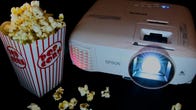Do you want the big-screen movie experience with the image quality and resolution of the real thing, but from the comfort of your own backyard? Or do you want the screen size of a massive monitor, for impressive presentations, but want something that can come with you on-the-go, skipping the hassle of lugging around a big TV? Then you need a portable projector. If you ask me, the best portable projector feature is the size. Most of these nifty, little contraptions are small enough that most could fit into an oversized coat pocket.
Whether you cast on a blank wall or a projector screen, you can capture the picture quality you crave without getting weighed down. They also offer a handful of connectivity options, and they typically run on batteries. Many mini projectors are set up to stream, giving you access to Netflix, Amazon Prime Video, Disney Plus, Hulu and other streaming services without having to connect another device.
Portable projectors do come with a few drawbacks, though. One is that many are relatively dim, lacking the brightness of a traditional home theater projector, meaning they can’t project as large an image as the big guys. Another is that even the best portable projectors often have lower resolution than their larger counterparts. If you’re never going to be far from an outlet, a standard projector will get you a much bigger, brighter and better image for similar money. But if you want something compact, portable and battery-powered, here are our top picks for best portable projector.
The Mars II Pro is the best compact projector option here due to its light output, overall image quality, ease of use and affordable price. This mobile device is a bit bigger than most other portable projectors here, but still small enough to hide completely under a six-pack of Coke.
The built-in 12,500-mAh is good for about 3.5 hours, longer if you just run it as a Bluetooth speaker. There are apps built in, some of which consider the Mars II a portable device, meaning you can download content to its 8GB internal memory for offline watching. The faux-leather strap also makes carrying the outdoor projector around super easy.
Although it costs more than the Anker Mars II Pro, this BenQ has more accurate color and a better picture overall. With 1080p resolution, compared to the Anker’s 720p, you’re less likely to see pixel structure or a “screen door effect” when watching from close up or with a really big image screen size. In most cases, however, 720p is just fine, making the Anker a superior value.
The PH30N is not only less expensive than the two above, it’s also tiny. This mini projector fits in my hand, yet creates a 720p image. It has an HDMI cable input plus a USB connection that might be able to run a streaming stick off the LG’s internal battery.
The stick connection is important because the LG lacks built-in apps. Light output is about half that of the Anker Mars II Pro and M2, though their contrast ratios are roughly the same. The internal portable mini projector battery should last around two hours in the projector’s dimmest mode. Less battery life if you’re also powering a streaming stick.
The mini projector fits in places other projectors won’t, however, making it, ahem, handy.
While we didn’t like it quite as much as the BenQ GS50, this small, flat Anker mini portable projector costs less. Its main disadvantage compared to the GS50 and the Anker Mars II Pro is its relatively dim image, which means it can’t project as large a picture and still look good. If you want a sleek, budget-friendly portable with 1080p and plan on keeping the image on the small side, however, this is a solid choice.
Portable projector FAQs
The biggest difference is light output. Traditional, full-size projectors can get much brighter than any portable mini projector. Most portable projectors use an LED lamp, while full-size projectors have either UHP lamps (which are basically high-powered lightbulbs) or laser light sources. Projector light output is measured in lumens. The brightest portable projectors we’ve reviewed measure about 350 lumens, while a traditional home theater projector measures 1,500 lumens or more.
A bright projector can produce a larger image, and looks better when there’s some ambient light around. For that reason dimmer portable projectors are best enjoyed with smaller images and in as dark an environment as possible.
Beyond brightness, mini projectors are much smaller (of course), can run on battery power and usually include built-in streaming and decent speakers. Traditional projectors have more lens adjustments, including focus, zoom and lens shift, and can run louder.
It depends. Many portable projectors have built-in batteries that can run for two or three hours before needing to be plugged in. Some can also attach to external USB battery packs that allow them to be run without plug-in power. On the other hand, many smaller portable projectors, especially cheaper ones, don’t include a built-in battery or work with battery packs. They will need to be plugged in to work.
Yes. Many mini projectors have built-in streaming that allow them to show Netflix and other streaming services when connected via Wi-Fi. For projectors that don’t have built-in streaming, you’ll need to connect another streaming device, like a Roku or Fire TV Stick, to the projector’s HDMI input to stream Netflix and other services.

